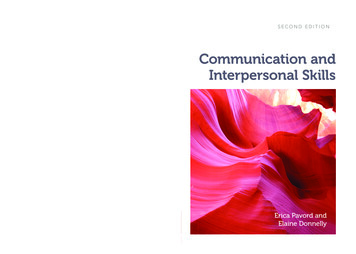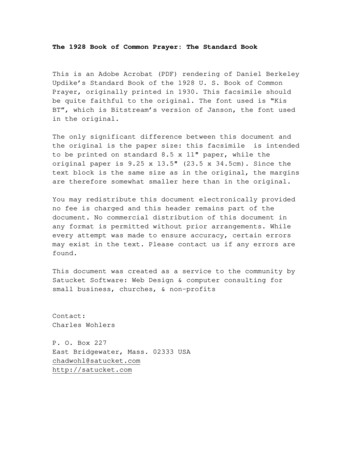
Transcription
The InterpersonalCommunication BookFIFTEENTH EDITIONJoseph A. DeVitoHunter College of the City University of New YorkA01 DEVI3108 15 SE FM.indd 111/8/17 6:00 PM
Director, Portfolio Management: Karon BowersContent Producer: Barbara CappuccioContent Developer: Angela KaoPortfolio Manager Assistant: Dea BarbieriProduct Marketer: Christopher BrownField Marketer: Kelly RossContent Producer Manager: Melissa FeimerContent Development Manager: Sharon GearyManaging Editor: Maggie BarbieriContent Developer, Learning Tools: Amy WetzelDesigner: Kathryn FootDigital Studio Course Producer: Amanda SmithFull-Service Project Manager: SPi GlobalCompositor: SPi GlobalPrinter/Binder: LSC Communications, Inc.Cover Printer: Phoenix Color/HagerstownCover Designer: Lumina Datamatics, Inc.Cover Images: 4x6/GettyImages; drbimages/GettyImagesAcknowledgments of third party content appear on pages 398–400, which constitutes an extension of this copyright page.Copyright 2019, 2016, 2013 by Pearson Education, Inc. or its affiliates. All Rights Reserved. Printed in the United States ofAmerica. This publication is protected by copyright, and permission should be obtained from the publisher prior to any prohibited reproduction, storage in a retrieval system, or transmission in any form or by any means, electronic, mechanical, photocopying, recording, or otherwise. For information regarding permissions, request forms and the appropriate contacts withinthe Pearson Education Global Rights & Permissions department, please visit www.pearsoned.com/permissions/.PEARSON, ALWAYS LEARNING, and Revel are exclusive trademarks in the U.S. and/or other countries owned by PearsonEducation, Inc. or its affiliates.Unless otherwise indicated herein, any third-party trademarks that may appear in this work are the property of their respectiveowners and any references to third-party trademarks, logos or other trade dress are for demonstrative or descriptive purposesonly. Such references are not intended to imply any sponsorship, endorsement, authorization, or promotion of Pearson’s products by the owners of such marks, or any relationship between the owner and Pearson Education, Inc. or its affiliates, authors,licensees or distributors.Library of Congress Cataloging-in-Publication DataNames: DeVito, Joseph A., author.Title: The interpersonal communication book / Joseph A. DeVito, HunterCollege of the City University of New York.Description: 15th edition. Boston : Pearson Education, Inc., 2017. Includes bibliographical references and index.Identifiers: LCCN 2017037905 ISBN 9780134623108 ISBN 013462310XSubjects: LCSH: Interpersonal communication.Classification: LCC BF637.C45 D49 2017 DDC 302.2--dc23 LC record available at https://lccn.loc.gov/2017037905118Instructor’s Review Copy:ISBN-10: 0-13-462446-7ISBN-13: 978-0-13-462446-4Access Code Card:ISBN 10: 0-13-462444-0ISBN 13: 978-0-13-462444-0à la carte Edition:ISBN-10: 0-13-462439-4ISBN-13: 978-0-13-462439-6Student Rental Edition:ISBN 10: 0-13-462310-XISBN 13: 978-0-13-462310-8A01 DEVI3108 15 SE FM.indd 211/8/17 6:00 PM
Brief ContentsPART ONEPreliminaries to Interpersonal Communication11Foundations of Interpersonal Communication2Culture and Interpersonal Communication293Perception of the Self and Others55PART TWOInterpersonal Messages1874Verbal Messages5Nonverbal Messages1166Listening1577Emotional Messages1818Conversational Messages205PART THREE9Interpersonal Relationships87236Interpersonal Relationship Stages, Communication, andTheories23610Interpersonal Relationship Types26711Interpersonal Conflict and Conflict Management30312Interpersonal Power and Influence327iiiA01 DEVI3108 15 SE FM.indd 311/8/17 6:00 PM
ContentsSpecialized ContentsWelcome to The InterpersonalCommunication BookviiiCommunication 1Foundations of InterpersonalCommunication1The Benefits of Studying InterpersonalCommunicationPersonal BenefitsProfessional BenefitsCulture and InterpersonalCommunication29CultureThe Importance of Cultural AwarenessThe Transmission of CultureThe Aim of a Cultural Perspective30303434Cultural DifferencesIndividual and Collective OrientationHigh- and Low-Context CulturesPower DistanceMasculine and Feminine CulturesHigh-Ambiguity-Tolerant and Low-AmbiguityTolerant CulturesLong- and Short-Term OrientationIndulgence and Restraint3739404041Principles for Effective Intercultural CommunicationEducate YourselfRecognize DifferencesConfront Your StereotypesReduce Your EthnocentrismRecognize Culture ShockAdjust Your Communication45464748495051Summary 53Key Terms 53ixPART ONE Preliminaries To Interpersonal12222The Elements of Interpersonal ContextEffectsEthics457910111213The Principles of Interpersonal CommunicationInterpersonal Communication Exists ona ContinuumInterpersonal Communication InvolvesInterdependent IndividualsInterpersonal Communication Is InherentlyRelationalInterpersonal Communication Is a TransactionalProcessInterpersonal Communication Serves a Variety ofPurposesInterpersonal Communication Is AmbiguousInterpersonal Relationships May Be Symmetricalor ComplementaryInterpersonal Communication Refers to Contentand RelationshipInterpersonal Communication Is a Series ofPunctuated EventsInterpersonal Communication Is Inevitable,Irreversible, and Unrepeatable16Summary 27Key Terms 28161717181921222224243Perception of the Self and Others42424355The Self in Interpersonal 56565860Perception in Interpersonal CommunicationStage One: StimulationStage Two: OrganizationStage Three: Interpretation–EvaluationStage Four: MemoryStage Five: Recall646565666767Impression FormationImpression Formation ProcessesIncreasing Accuracy in Impression Formation696974Impression Management: Goals and Strategies78To Be Liked: Affinity-Seeking and Politeness Strategies 79ivA01 DEVI3108 15 SE FM.indd 411/8/17 6:00 PM
ContentsTo Be Believed: Credibility StrategiesTo Excuse Failure: Self-Handicapping StrategiesTo Secure Help: Self-Deprecating StrategiesTo Hide Faults: Self-Monitoring StrategiesTo Be Followed: Influencing StrategiesTo Confirm Self-Image: Image-Confirming Strategies818282838383Summary 85Key Terms 86PART TWO4Interpersonal MessagesVerbal MessagesPrinciples of Verbal MessagesMessages Are PackagedMessage Meanings Are in PeopleMeanings Are Denotative and ConnotativeMessages Vary in AbstractionMessages Vary in PolitenessMessages Can Be Onymous or AnonymousMessages Can DeceiveMessages Vary in Assertiveness8787888888899091939496Confirmation and ral Identifiers100101102103104105Guidelines for Using Verbal Messages EffectivelyExtensionalize: Avoid Intensional OrientationSee the Individual: Avoid AllnessDistinguish between Facts and Inferences:Avoid Fact–Inference ConfusionDiscriminate Among: Avoid IndiscriminationTalk about the Middle: Avoid PolarizationUpdate Messages: Avoid Static Evaluation108108109Summary 114Key Terms 1155Nonverbal Messages109111111112116Principles of Nonverbal CommunicationNonverbal Messages Interact with Verbal MessagesNonverbal Messages Help Manage ImpressionsNonverbal Messages Help Form RelationshipsNonverbal Messages Structure ConversationNonverbal Messages Can Influence and DeceiveNonverbal Messages Are Crucial forExpressing Emotions117118119119120121Channels of Nonverbal CommunicationBody MessagesFacial CommunicationEye CommunicationTouch CommunicationParalanguage123123126129132134A01 DEVI3108 15 SE FM.indd 5122vSilenceSpatial Messages and TerritorialityArtifactual CommunicationOlfactory MessagesTemporal Communication136138141144145Nonverbal Communication CompetenceEncoding SkillsDecoding Skills151152153Summary 155Key Terms 1566Listening157The Process and Skills of ListeningStage One: ReceivingStage Two: UnderstandingStage Three: RememberingStage Four: EvaluatingStage Five: Responding158159160161162163Listening BarriersPhysical and Mental DistractionsBiases and PrejudicesRacist, Heterosexist, Ageist, and Sexist ListeningLack of Appropriate FocusPremature JudgmentHearing Impairment165165165165166166167Styles of Effective ListeningEmpathic ListeningPolite ListeningCritical ListeningActive Listening168169170172173Culture, Gender, and ListeningCulture and ListeningGender and Listening176177178Summary 180Key Terms 1807Emotional Messages181Principles of Emotions and Emotional MessagesEmotions Occur in StagesEmotions May Be Primary or BlendedEmotions Involve Both Body and MindEmotional Expression Uses Multiple ChannelsEmotional Expression Is Governed by DisplayRulesEmotions Can Be Used StrategicallyEmotions Have ConsequencesEmotions May Be Adaptive and MaladaptiveEmotions Are Contagious183184185186187Obstacles to Communicating EmotionsPersonality FactorsInadequate Interpersonal SkillsSocietal and Cultural CustomsFear19319319319419518818919019019111/8/17 6:00 PM
vi ContentsEmotional CompetenceEmotional ExpressionEmotional Responding196196201Summary 204Key Terms 2048Conversational Messages205Principles of ConversationThe Principle of ProcessThe Principle of CooperationThe Principle of PolitenessThe Principle of DialogueThe Principle of Turn Taking206206208210211212Conversational DisclosureRevealing YourselfInfluences on Self-DisclosureRewards and Dangers of Self-DisclosureGuidelines for Self-Disclosure215215216217219Everyday ConversationsMaking Small TalkMaking IntroductionsMaking ExcusesApologizingAsking for a Summary 235Key Terms 235PART THREE InterpersonalRelationships 9Interpersonal Relationship Stages,Communication, and Theories236238240240241241242243243Relationship CommunicationCommunicating in Developing and MaintainingRelationshipsCommunicating in Deteriorating and DissolvingRelationshipsCommunicating in Relationship Repair246Relationship TheoriesAttraction TheoryRelationship Rules TheoryRelationship Dialectics TheorySocial Exchange TheoryEquity Theory255255258260261262246248251262265Key Terms 26610Interpersonal Relationship Types267Friendship RelationshipsDefinition and CharacteristicsFriendship TypesFriendship NeedsFriendship and CommunicationFriendship, Culture, and Gender269269270272272274Love RelationshipsLove TypesLove and CommunicationLove, Culture, and Gender276277279280Family RelationshipsCharacteristics of FamiliesCouple TypesFamily TypesFamily and CommunicationFamilies, Culture, and Gender281282283284285287Workplace RelationshipsWorkplace CommunicationNetworking RelationshipsMentoring RelationshipsRomantic Relationships at Work289289291292293The Dark Side of Interpersonal RelationshipsJealousyViolence296296297Summary 301Key Terms 30211236Relationship rDissolutionMovement among the StagesA01 DEVI3108 15 SE FM.indd 6Politeness TheorySummary Interpersonal Conflict and ConflictManagement303Preliminaries to Interpersonal ConflictDefinition of Interpersonal ConflictMyths about Interpersonal ConflictInterpersonal Conflict Issues304304305305Principles of Interpersonal ConflictConflict Is InevitableConflict Can Have Negative and PositiveEffectsConflict Is Influenced by Culture and GenderConflict Styles Have ConsequencesConflict Management Is a Multistep Process308308Conflict Management StrategiesWin–Lose and Win–Win StrategiesAvoidance and Active Fighting StrategiesForce and Talk StrategiesFace-Attacking and Face-Enhancing StrategiesVerbal Aggressiveness and ArgumentativenessStrategies317319320321322Summary 326Key Terms 32630830931131332311/8/17 6:00 PM
Contents12Interpersonal Power and Influence327Principles of Power and InfluenceSome People Are More Powerful Than OthersPower Can Be SharedPower Can Be Increased or DecreasedPower Follows the Principle of Less InterestPower Generates PrivilegePower Is Influenced by Culture328328329330330331331Relationship, Person, and Message PowerPower in the RelationshipPower in the PersonPower in the MessageResisting Power and Influence333333335337340Misuses of Power342A01 DEVI3108 15 SE FM.indd 7Sexual HarassmentBullyingPower Playsvii342344346Prosocial CommunicationThe Nature of Prosocial CommunicationFactors Influencing Prosocial CommunicationExamples of Prosocial CommunicationEffects of Prosocial Communication348348348349350Summary 351Key Terms 17 6:00 PM
Specialized ContentsUnderstanding Interpersonal SkillsMindfulness: A State of Mental Awareness (Chapter 1)15Cultural Sensitivity: Responsiveness to CulturalVariation (Chapter 2)36Other-Orientation: A Focus on the Other Personand that Person’s Perspective (Chapter 3)68Metacommunication: The Ability to Talk aboutYour Talk (Chapter 4)99Long-Term Versus Short-Term Orientation (Chapter 5)148Politeness (Chapter 6)172Indulgent and Restraint Orientation (Chapter 7)187Apologies (Chapter 8)229Relationship Length (Chapter 9)248Masculine and Feminine Orientation (Chapter 10)275Success (Chapter 11)312High- and Low-Power Distance (Chapter 12)332Immediacy: Interpersonal Closeness andTogetherness (Chapter 5)151Integrated ExperiencesOpenness: Willingness to Disclose andbe Honest (Chapter 6)177Interpersonal Communication: Easy andDifficult (Chapter 1)195Beliefs about Interpersonal Communication(Chapter 1)Flexibility: The Ability to Change CommunicationPatterns to Suit the Situation (Chapter 7)Expressiveness: Communication of GenuineInvolvement (Chapter 8)222Empathy: Feeling What Another Person FeelsFrom That Person’s Point of View (Chapter 9)254Supportiveness: Supportive Messages That ExpressUnderstanding Rather Than Evaluation (Chapter 10)288Equality: An Attitude and a Pattern of Behaviorin Which Each Person Is Treated as InterpersonallyEqual316Interaction Management: Your Ability to Carryon an Interpersonal Interaction Smoothly andEffectively (Chapter 12)341Ethics in Interpersonal CommunicationEthical Standards (Chapter 1)14Culture and Ethics (Chapter 2)36The Ethics of Impression Management (Chapter 3)82Ly
PART ONE Preliminaries to Interpersonal Communication 1 1 Foundations of Interpersonal Communication 1 2 Culture and Interpersonal Communication 29 3 Perception of the Self and Others 55 PART TWO Interpersonal Messages 87 4 Verbal Messages 87 5 Nonverbal Messages 116 6 Listening 157 7 Emotional Messages 181 8 Conversational Messages 205 .











